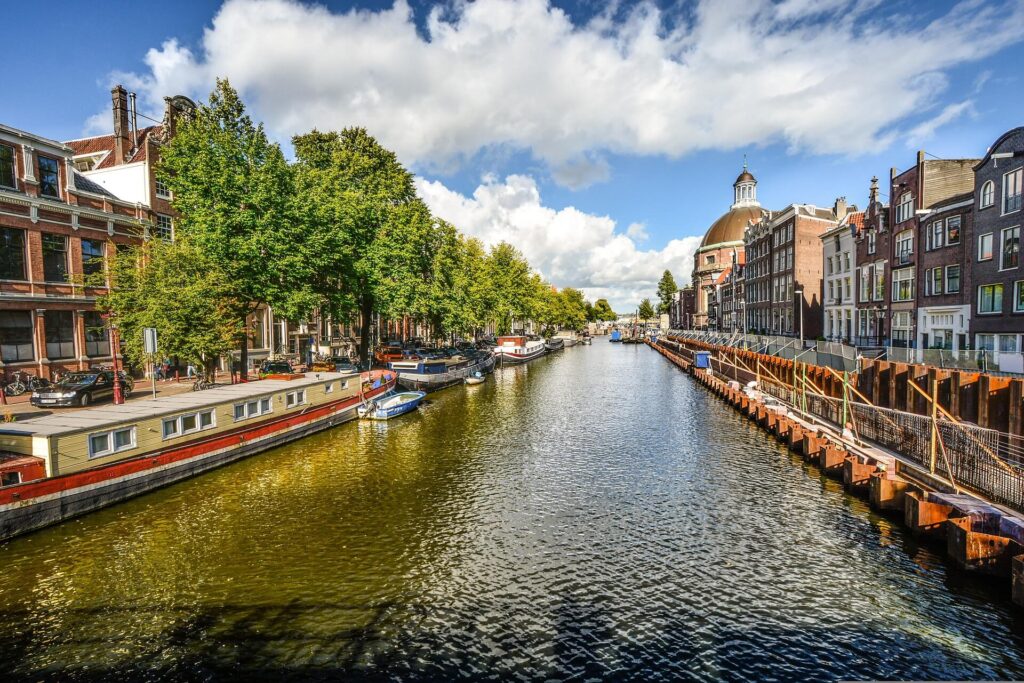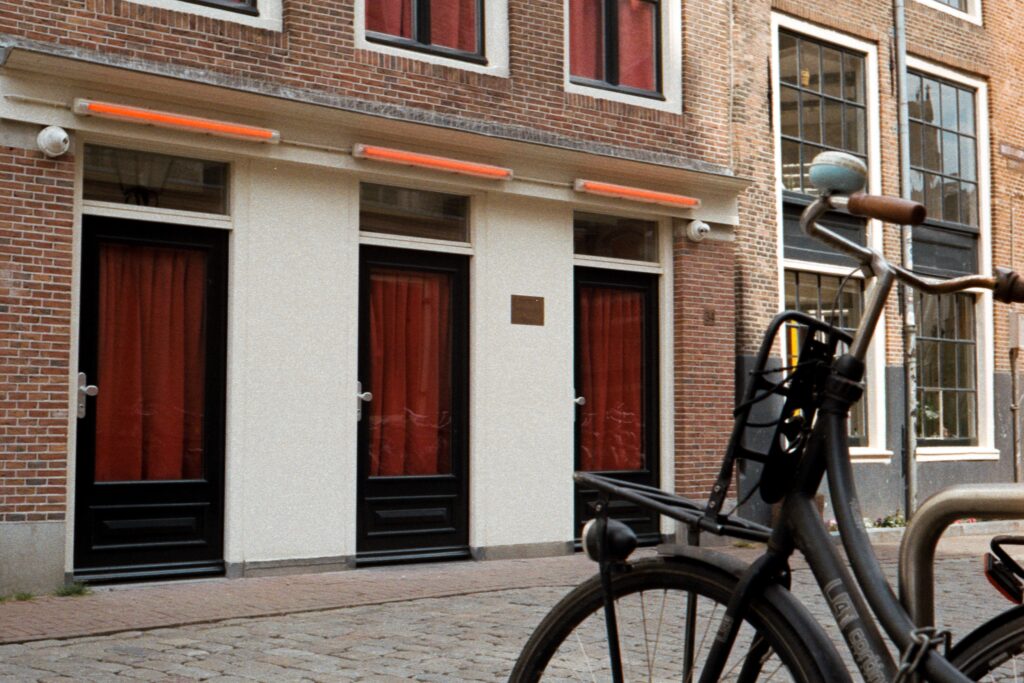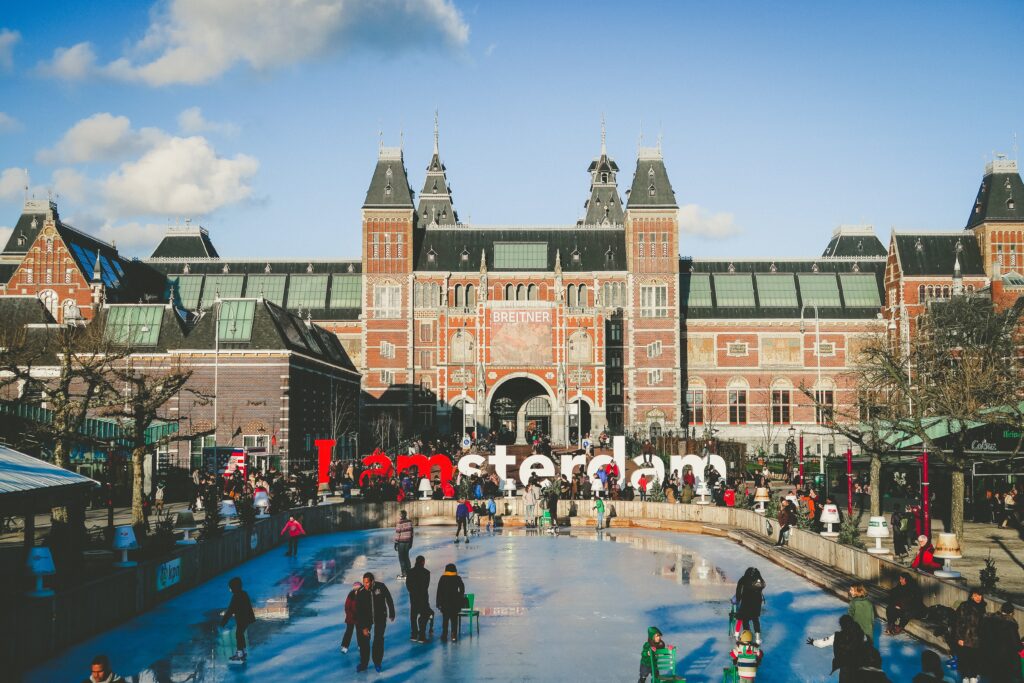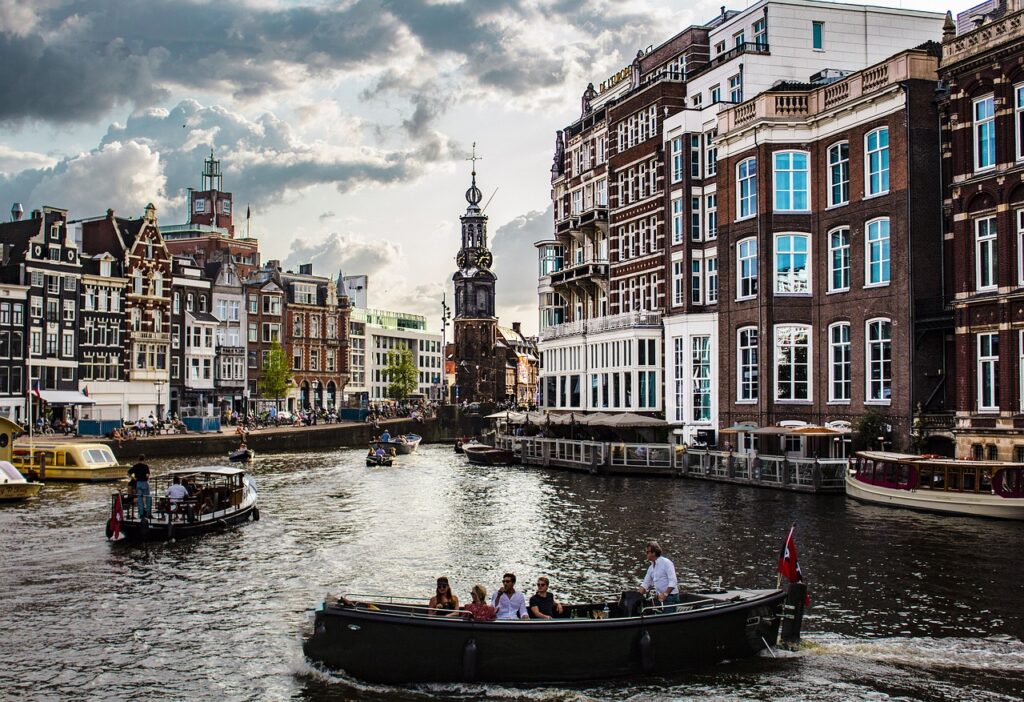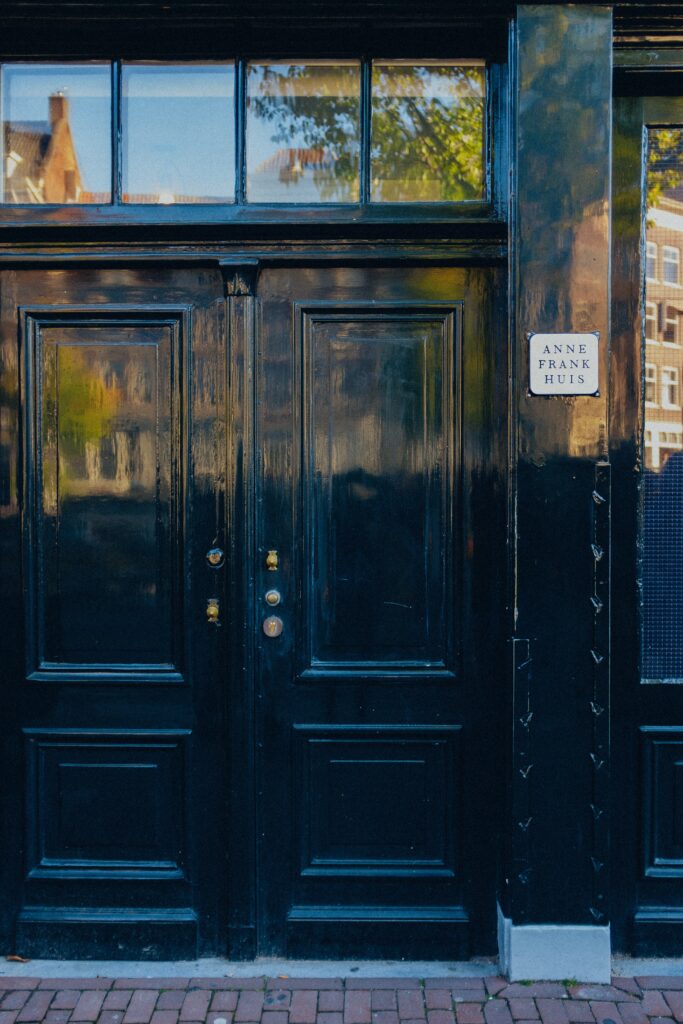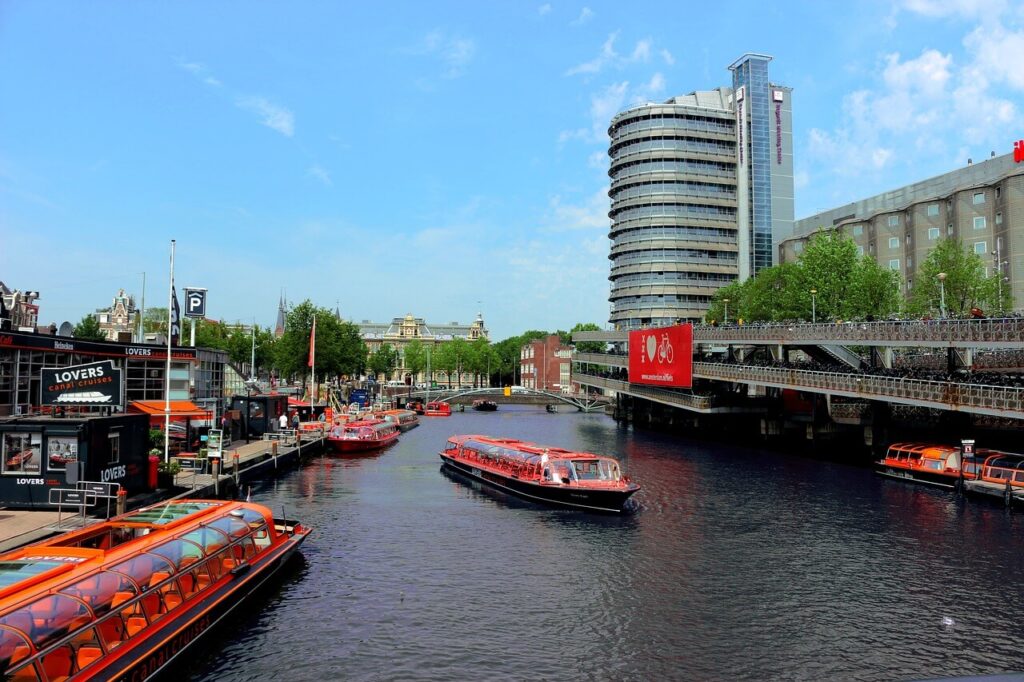Location: Center of Amsterdam.
What is it? Amsterdam’s canal system, consists of more than 100 waterways. That’s why the cities nickname is “Venice of the North.” Picture yourself floating down an idyllic river with the sound of a lovely song cascading behind the busy metropolis. The architectural styles of the famous canal houses unfold as you cruise past them. These exquisite examples of Baroque and Renaissance art from the 17th century provide witness to the great artistic tradition of the city. The canal ring is a UNESCO World Heritage Site. Be sure not to miss the “Skinny House”. The beautifully small home whose exterior defies conventions in architecture.
Why to go? This landmark serves as a reminder of Amsterdam’s inventiveness and capacity for space adaptation. As an impressive contrast, you might see a canal house. Representative of the richness and success of the city during its Golden Age. You’ll see how deeply water is intertwined into Amsterdam’s history and identity as you float among the canals.
Location: Along the IJ River.
Open: Daily, hours vary seasonally.
Ticket Fee: Entrance fee around €15.
What is it? A canal tour is more than just an instrument of discovery. It’s a journey across time. You’ll get an idea of the city’s development as you cruise by sites that date back hundreds of years. From it’s modest beginnings as a little fishing village to the Golden Age. When it came to prominence as a major maritime force worldwide. Visualize yourself in a comfortable seat on a canal boat. Let the gentle rhythm of the water carry you away to a past period.
Why to go? Picture the city spreading out in front of you like a frame from a masterwork by the Dutch. The canal houses facade are illuminated by the sunlight reflecting off the water. The Houseboat Museum provides an look into the unique style of life that comes with being on the water. A concept that is as Amsterdam specific as they get. See how locals have accepted a life by the ocean and made creative use of available space.
Location: De Wallen District, Amsterdam.
What is it? The Red Light District of Amsterdam is a source of both controversy and intrigue. A neighborhood that is not like any other. Here, a thriving nightlife scene and cannabis cafes coexist with legalized prostitution. See the tiny lanes with windows that glow red. Remember to show the women that work there some respect. Even though it’s a well liked tourist spot. It’s crucial to act politely and refrain from snapping pictures without permission. There’s also a long history in this area. Originating from the city’s earliest years as a significant port. After lengthy sea trips, sailors came to this area in search of pleasure. It opened out into a busy red light area.
Why to go? The Red Light District is still a hotbed of social controversy and historical relevance today. Some regard it as an example for harm reduction and tolerance. While others see it as a kind of authorized exploitation. Whatever viewpoint you have, the Red Light District serves as window into another Amsterdam. One where cultural norms are challenged and acceptance is the rule.
Location: Center of Amsterdam.
What is it? Enjoy Vondelpark’s peace and quiet as you escape the noise of the city. The largest urban green park in Amsterdam. Residents walk down tree lined pathways with their dog friends. Large lawns scattered with sunbathers soaking up the warm Dutch weather. This paradise is referred to as “Amsterdam’s Central Park”. Wander around the lovely rose garden, where colorful blossoms in every shade of the rainbow weave a beautiful symphony. Find yourself in an engrossing novel. Visit the Openluchttheater. The outdoor theater comes to life in the summer, for a taste of culture. Offering a range of acts, including modern plays and classical concerts.
Why to go? Create a picnic basket with a bottle of Dutch wine, freshly made bread and cheese from the local store. Snuggle up behind a tree for shade. Allow the soft sound of songbirds to soothe you. Let your cares about the outside world fade. This haven is more than simply a park. It’s a microcosm of Amsterdam.
Location: Along the IJ River.
What is it? Take a free ride on one of Amsterdam’s many ferries. They transport passengers between the IJ River, link Amsterdam Noord. The once industrial neighborhood with the city center. Take in the panorama of the famous skyline of Amsterdam. Explore the fashionable shops, art galleries and stylish cafes that line the riverfront as you depart at Amsterdam Noord. Explore boutiques featuring locally designed apparel or discover one of a kind finds in a vintage market. Visit the Amsterdam Marine Museum (Scheepsvaartmuseum) to learn more about the marine heritage of the city. The NDSM port is one undiscovered gem you may find. A cultural hub with art installations and exciting events. See a movie or take in a live music show in a refurbished warehouse.
Why to go? Grab a free ferry to Amsterdam Noord and leave the tourist path for a bit. This neighborhood, with it’s mix of industrial heritage, hip restaurants and creative spirit, provides a welcome diversion from the city center. You may find your new favorite spot in Amsterdam.
Location: Schiphol Plaza or Sloterplas Park.
What is it? Abandoned is the once iconic “I amsterdam” sign that was a permanent fixture on Museumplein for more than ten years. Nevertheless, many tourists used it as a spot for pictures. The sign came to represent traffic and a burden on the city’s resources. When the “I amsterdam” sign was first put up in 2004 as part of a marketing campaign, it gained popularity right away. With the red and white letters, tourists swarmed to take the ideal selfie. Frequently forming huge lines and obstructing pedestrian traffic. There were drawbacks to the popularity spike. Locals believed that the sign gave visitors priority over locals. The surrounding infrastructure suffered by the numerous people. The controversial decision to have the sign removed was made by the city council in 2018. The idea of “I amsterdam” is still present even after it was removed. The deconstructed letters have relocated to some of the city’s less well known areas. The “I amsterdam” letters are now available for photos at Schiphol Plaza. Which is close to the airport. Or you may go on a treasure hunt to find them spread across Sloterplas Park.
Why to go? The goal of this dispersion is to promote exploration outside of the city center and more equitably distribute tourism. Amsterdam offers a wealth of experiences that go beyond a picture opportunity. Whether you’re a native relieved by its departure or a sentimental traveler missing the old sign. Visit institutions such as the Rijksmuseum to learn about the history. Discover galleries such as the Stedelijk Museum and lose yourself in the art scene.
Location: Center of Amsterdam.
Open: Daily, 10am to 10pm.
What is it? Consider a world where tall bookshelves overflow with tales awaiting discovery. Where quiet whispers blend in with the soft turn of pages. The Amsterdam Public Library (Openbare Bibliotheek Amsterdam, OBA) is this haven for bookworms. A masterpiece of contemporary architecture that combines form and function perfectly. Enter the eye catching glass and steel OBA building. Witness the difference from the city’s old canal houses. The large interior is flooded with natural light, highlighting the modern architecture and enticing you to look around. Explore the large collection of books, periodicals and multimedia materials. Which includes sections dedicated to history, art, literature from around the world. The OBA fulfills all literary cravings, whether you’re a devoted reader looking for a classic book or an eager traveler hoping to discover new writers. Unwind in the cozy reading nooks while focused in a novel.
Why to go? Get together with other book enthusiasts by going to a literary event or workshop. A large movie theater with a selection of independent and foreign films is another highlight. Explore the Amsterdam Archives, located in the library. Providing a wealth of records and artifacts detailing the history of the city, for a taste of the past. So, take a break from sightseeing and find yourself in intellectual stimulation.
Location: Center of Amsterdam.
Open: Daily, 10am to 10pm.
Ticket Fee: Fee around €20 per day.
What is it? Ditch the taxis and public transport and rent a bike to truly experience the city like a local. The bicycle is the undeniable king of Amsterdam’s streets. Just picture the adrenaline rush of speeding down specially designed bike lanes. The wind tearing through your hair while you make your way through the busy streets. Amsterdam has more than 800 kilometers of bike lanes, making it a cyclist’s dream city.
Why to go? Riding a bicycle let’s you discover the city at your own leisure, discovering picturesque canals, surprising corners and hidden lanes. Take a moment to appreciate the street art hidden along a small side street. Sip coffee in a tiny a cafe along a charming canal. Remember to use hand signals, respect to pedestrians and show consideration for other cyclists when cycling. Accept life on two wheels and experience the delight of riding a bike across Amsterdam.
Location: Singel, Amsterdam.
Open: Monday to Saturday, 9am to 5pm.
What is it? Visualize colored and fragrant canvas. You may expect a sensory overload at the Bloemenmarkt. The flower market described best when the joyful conversation of buyers blends with the scent of tulips in bloom. The Bloemenmarkt, next to the Singel canal, has existed in the city since the 17th century. An evidence of the Dutch passion for flowers. Wander by the flower stands that are exploding with bright colors. The Netherlands iconic flower, colorful tulips, steals the show due to their countless variations. The visual feast is created by fragrant lilies and delicate orchid. Roses in every shade are offered and a variety of exotic flora.
Why to go? Go past the cut flowers and explore booths filled with gardening materials, seeds and bulbs. All ideal for bringing a little bit of the Dutch floral charm home with you. So come to this famous flower market, submerged yourself in the pandemonium. Go celebrate springtime at any time of year.
Location: Center of Amsterdam.
Ticket Fee: Entrance around €20 per day.
What is it? Think about an hidden shelter in the center of a Amsterdam. The Anne Frank House is a heartbreaking space. Honors one of humanity’s darkest tragedies. Step back in time to the aftermath of WWII. Follow the story of Anne Frank and her family. Hiding from Nazi persecution in a secret part of her father’s office building for two years. The Anne Frank House is truely more than just a museum. Showcasing a living example of determination and strength. As you explore the small living quarters and hidden annex, your imagination fills in the missing details of their daily life. Read passages from Anne’s journal, a remarkable book that captures her hopes, anxieties and dreams. While facing the constant possibility of discovery. Standing in the silent room where Anne wrote her now famous words. You can feel the weight of history crushing down.
Why to go? The Anne Frank House is an unsettling symbol of the acts of violence of war and the importance of tolerance. It also highlights the enduring power of the human spirit, as Anne’s words of hope and tenacity continue to motivate future generations. A visit to the Anne Frank House is not for the faint of heart, but it is a necessary experience for better comprehending this pivotal period in history. Tickets sell rapidly, so reserve yours early. Allow plenty of time for your visit. As the museum can become crowded and be moved by Anne Frank and her family’s dramatic narrative.
Amsterdam, known for its canals, culture, and complex history, has left an impression on many travelers. This city is a mix of history, art, and passion for life. Serving every tourist with an unforgettable journey. Whether you’re a an enthusiast who wants a glimpse into the Golden Age. No? Maybe an art lover looking for masterpieces? Or simply a curious mind in need of an escape. Amsterdam has something to offer for everyone.
Is Amsterdam safe for solo travelers?
The majority of individuals agree that Amsterdam is a safe place for single visitors. Always take standard safety measures, as in any large city. Don’t walk alone at night and be mindful with your belongings.
When is the best time to visit Amsterdam?
The autumn (September to November) and spring (March to May) seasons offer beautiful weather. You will perhaps see less people. The city might get really crowed in the summer months (June to August). However there are lots of festivals and events to take part in, The Winter months (December to February) can be chilly and wet. Have in mind the charm of Christmas lights and warm drinks serving in cozy cafes. The ideal time to go will ultimately depend on your tastes and level of crowd tolerance.
Which currency is accepted in Amsterdam?
The Euro (EUR) is the accepted form of payment. Although credit cards are used at many stores and restaurants. It’s a good idea to carry cash on hand for smaller purchases and tickets for public transportation.
What is the language used in Amsterdam?
Dutch is the official language, but English is also widely spoken and used there. Especially in the tourist districts. Being able to say simple words like “Dank u wel” (Thank you) and “Hallo” (Hello) in Dutch will go a long way toward being respectful of the people there.
What are some famous traditional Dutch dishes I need to try?
Dutch cuisine offers a variety of hearty dishes. Starting with some savory dishes like “Stamppot” (mashed potatoes with vegetables) or “Hutspot” (stew with vegetables and meat). The super tasty and famous sweets are called “Poffertjes” mini pancakes. They are covered with powdered sugar. Don’t forget to get try the typical Dutch “Stroopwafel” (syrup waffle). Matched perfectly with with a cup of coffee.
